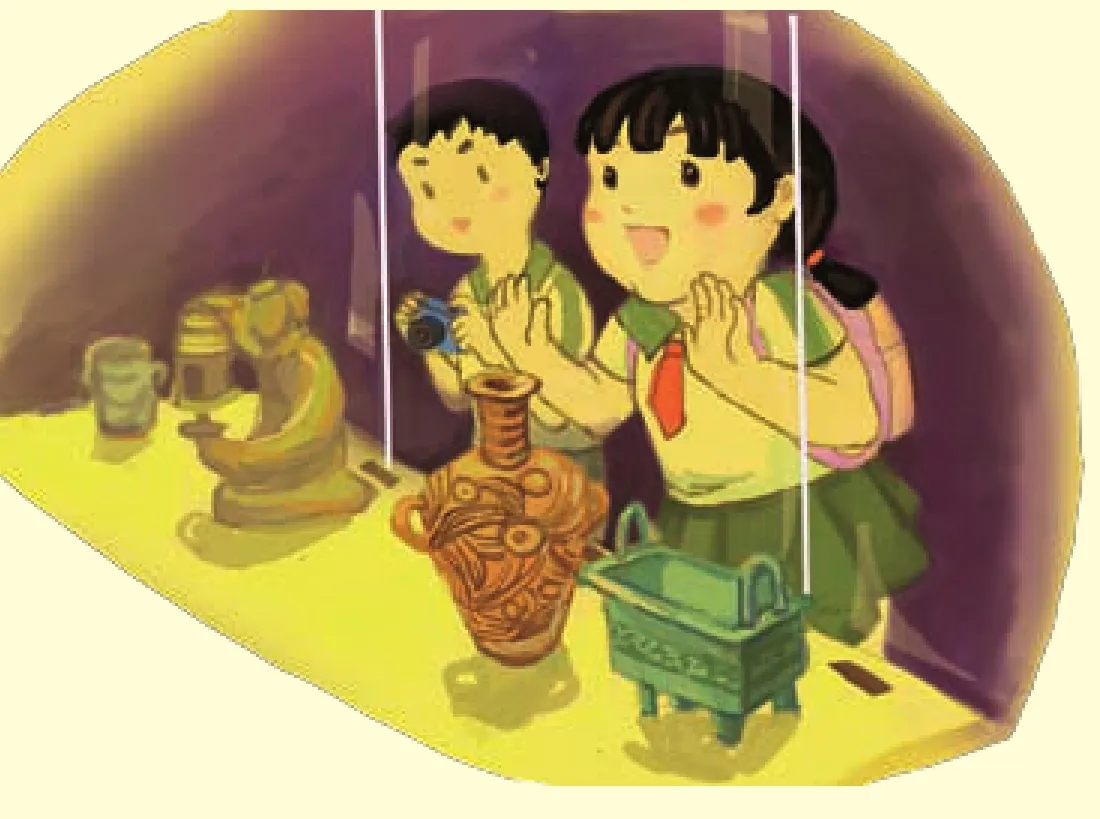博物馆
——学习、玩耍两不误!
本篇适合:
朗读、挑战
插画:吴兆盈
博物馆
——学习、玩耍两不误!
Learn and Play in Museums!
本篇适合:
朗读、挑战

插画:吴兆盈
每年的5月18日是国际博物馆日。这个节日由国际博物馆协会发起并创立,目的是为了促进全球博物馆事业的健康发展,吸引全社会对博物馆事业的了解、参与和关注。
同学们,你们常去博物馆吗?你们喜欢去博物馆吗?你们对博物馆有多少了解呢?“博物馆”一词,源于希腊文“缪斯庵”(mouseion),原意为“祭祀缪斯的地方”。缪斯(muses)是希腊神话中掌管科学与艺术的九位神女的统称,她们分别掌管着历史、天文、史诗、情诗、抒情诗、悲剧、喜剧、圣歌和舞蹈,代表着当时希腊人文活动的全部。
随着时代的进步,博物馆已经成为人们社会生活中不可缺少的部分,它让普通人也能近距离地接触历史、艺术和科学。走进博物馆,你将走进一个不一样的奇妙世界。
by Sea
What Is a Museum?
A museum is a place where one can see rare things saved for show. They have great historical and cultural value. There is a museum in almost every city.


The purposes of a museum are for education, study and enjoyment.

What Are Saved in a Museum?
There are things like old sculptures, old coins, old paintings, musical instruments, dresses, swords of kings, jewels of queens and so on.
The museum also keeps skeletons of animals from the past, like the skeletons of dinosaurs.
Kinds of Museums
Museums can be about different things such as art and science. There are many kinds of museums, including art museums, natural history museums, science museums, war museums, children’s museums and so on.

Why Do People Go to Museums?
People go to museums to learn, or to have fun. Visitors can see and educate themselves about the articles they see. Details are given under each article. There are many interesting parts in the museum. The children’s part is separate. Toys are kept there.


rare [reə] adj. 稀罕的,珍贵的
save [seɪv] v. 保存(过去分词:saved)
historical [hɪ'stɒrɪkl] adj. 历史的
cultural ['kʌltʃərəl] adj. 文化的
value ['væljuː] n. 价值,意义
almost ['ɔːlməʊst] adv. 几乎,差不多
purpose ['pзːpəs] n. 目的(复数:purposes)
education [,edʒʊ'keɪʃn] n. 教育
enjoyment [ɪn'dʒɔɪmənt] n. 享受
sculpture ['skʌlptʃə] n. 雕刻品(复数:sculptures)
instrument ['ɪnstrəmənt] n. 乐器
(复数:instruments)
sword [sɔːd] n. 剑,刀(复数:swords)
jewel ['dʒuːəl] n. 宝石,宝石饰物
(复数:jewels)
skeleton ['skelɪtn] n. 骨架(复数:skeletons)
dinosaur ['daɪnəsɔː] n. 恐龙(复数:dinosaurs)
include [ɪn'kluːd] v. 包括(-ing形式:including)
article ['ɑːtɪkl] n. 物品(复数:articles)
detail ['diːteɪl] n. 细节,详情(复数:details)
separate ['sepərət] adj. 分开的,单独的
Famous Museums
Some of the museums with the most visitors include the Louvre in Paris, the National Museum of China in Beijing, the National Museum of Natural History and the National Air and Space Museum in Washington D.C., the British Museum and the National Gallery in London.

中文大意请见第44页。


Louvre ['luːvrə] n. 卢浮宫(法国国立美术博物馆)
National Gallery ['næʃnəl 'gælərɪ] (英国伦敦)国家美术馆

除了我们常见的综合性博物馆,世界各地还有许许多多单独为某类事物专门创办的博物馆,它们特别又新奇,总有一些超乎你的想象,快来看看其中的几个吧!
中国:风筝博物馆
中国潍坊风筝博物馆是目前世界上面积最大的风筝专业博物馆,收藏了古今中外的风筝珍品以及有关风筝的文物资料2000余件,介绍了风筝的历史、分类和新发展。
英国:芥末博物馆
在英国诺福克,科尔曼芥末博物馆可能对芥末表达了最大的敬意。在这里你可以品尝到各种口味的芥末,也可以学习芥末的形成和演变史。
印度:国际厕所博物馆
这座博物馆展出了来自世界各国的厕所:从维多利亚时代的夜壶,到世界上第一个抽水马桶;从公元前2500年的便器,到还在概念中的未来高科技节水型厕所。
美国:午餐肉博物馆
午餐肉也成了“馆藏文物”。你想知道的关于午餐肉的一切,以及美国战后的饮食,都可以在明尼苏达州奥斯汀市的午餐肉博物馆找到。

